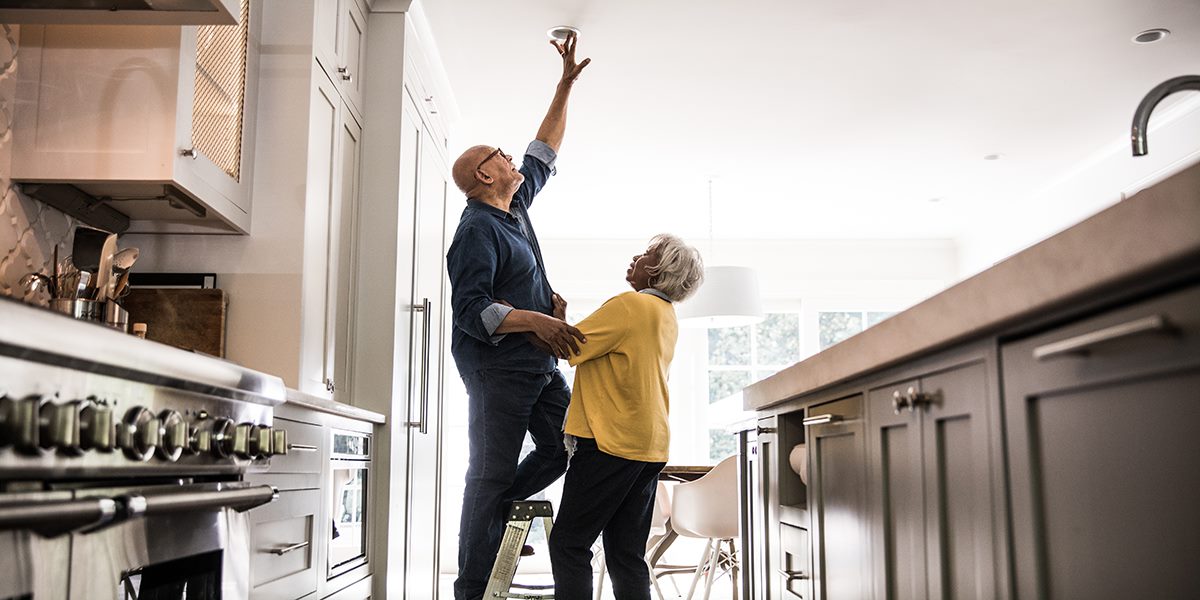Seniors are at higher risk for illnesses and injuries – even at home. Here are some affordable ways to improve their living situation.

You may know by now that older Canadians or seniors face a higher risk of developing serious complications from COVID-19. But the risk factor doesn’t end there.
Seniors are also more likely to face injuries that can damage their health. According to the Public Health Agency of Canada, falls are one of the leading causes of injury-related hospitalizations among seniors.
And, with the second wave of COVID-19 well underway, hospitals and health-care facilities may have trouble providing full services to everyone. So what’s the solution to helping the elderly right now? The best answer may be to take preventive steps at home to protect the seniors in your life.
Are any of your senior family members living alone? Or perhaps some of your elderly relatives have moved in with you during the pandemic? In such cases, here are some ways you can help create a safe and healthy home environment for them.
And, if you’re worried about how much it’ll cost you or your elderly family member, we’ll go over some savings opportunities that can help with the expense.
Home safety risks for seniors or anyone aging at home
Start by taking a look at where your elderly loved ones live – whether it’s in your home, theirs or at a facility. Find out if there are any problem areas for falls. This can include:
- stairs without handrails,
- slippery floor surfaces such as stone or ceramic tile,
- small rugs without underpadding,
- poorly lit rooms,
- kitchens with high shelves and little counter space,
- rooms cluttered with furniture and other items that prevent easy passage,
- bathrooms without grab bars or rails, and
- decks or patios with broken planks/stones.
After you catch the problem spots, you can begin looking into ways to fixing them.
- For more information on keeping your home safe, see the Public Health Agency of Canada’s Guide to Health Safety for Seniors.
10 important home upgrades and renovations for seniors
While some hazards are difficult to change, such as steep stairwells, there are many that can be addressed. And much of what you can do is budget-friendly and fairly easy to undertake. Here are some safety ideas to consider:
- Add lighting to high-traffic areas to illuminate trip hazards, or motion-activated lights for nighttime bathroom visits.
- Install two railings on each side of a staircase for extra stability.
- Choose non-slip flooring, or apply a non-stick coating to existing flooring.
- Remove slippery throw rugs or anchor them with an underpad or two-sided tape.
- Add storage bins or lower shelving to kitchens where upper cabinets require a stepstool or chair to reach. This will allow easy access and prevent having to reach or climb up.
- Install bath seats in showers with a hand-held shower head. Or, attach grab bars to the wall and edge of the tub and adjacent to the toilet. Place non-skid mats in and around bathtubs.
- Station cordless phones throughout the home to reduce the need for rushing to answer a single unit. Set the ringer to maximum volume and at the longest ring setting.
- Instead of venetian blinds, opt for draperies or curtains that are easier to pull open without reaching.
- Spread out your furniture to allow easy movement through each room.
- Get a personal response device that can sound an alarm if an elderly person falls at home. Worn on the wrist or on a chain around the neck, it detects falls and can notify a monitoring firm to call for help.
How to pay for home improvements or repairs for seniors
Worried about the cost of these home repairs? Here are some ways you can cover or offset the expenses:
1. Save and grow your money in a tax-free savings account (TFSA).
With a TFSA, you can grow your money with various kinds of investments. This includes bonds, stocks, mutual funds and exchange-traded funds – not just cash.
TFSA contributions aren’t tax deductible. But since you’ve already paid income tax on the money you put in your TFSA, you won’t have to pay tax when you take it out. And, any investment income you earn won’t be taxed – not even when you take the money out of your TFSA. You’re also free to use that money for any purpose.
If you’re responsible for helping aging parents, a TFSA can be a great way to help them with the cost of aging. For example, let’s say your parents can’t cover the cost of home-safety renovations. In such a case, you can use your TFSA – or give your parents money to contribute to TFSAs in their names, if you’ve maxed out the contributions to your TFSA – to help them make ends meet.
2. Take advantage of the Home accessibility tax credit (HATC).
Need to have a wheelchair ramp, walk-in bathtub or grip bar built into your home or a relative’s home? Then make the most of the non-refundable home accessibility tax credit (HATC). It’s a federal credit of up to $1,500 per calendar year, per individual.*
(*A non-refundable tax credit reduces your tax bill. For example, a tax credit of $500 will directly lower your tax bill by $500.)
To claim this credit, your renovation must make things easier for the care-receiver, whether it’s:
- gaining better access to a home,
- being more mobile within that space or
- reducing the risk of harm or injury.
Here are a few items that count as an eligible renovation under the HATC:
- grab bars,
- hand rails,
- walk-in tubs,
- wheel-in showers,
- widening doorways for wheelchairs and
- lowering cabinets.